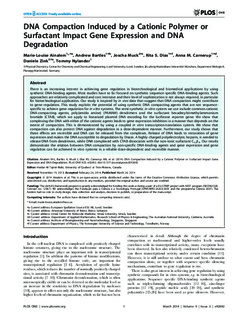DNA compaction induced by a cationic polymer or surfactant impact gene expression and DNA degradation
Ainalem, Marie-Louise; Bartles, Andrew; Muck, Joscha; Dias, Rita de Sousa; Carnerup, Anna M.; Zink, Daniele; Nylander, Tommy
Journal article, Peer reviewed
Permanent lenke
http://hdl.handle.net/11250/2367303Utgivelsesdato
2014Metadata
Vis full innførselSamlinger
- Institutt for fysikk [2677]
- Publikasjoner fra CRIStin - NTNU [37703]
Sammendrag
There is an increasing interest in achieving gene regulation in biotechnological and biomedical applications by using synthetic DNA-binding agents. Most studies have so far focused on synthetic sequence-specific DNA-binding agents. Such approaches are relatively complicated and cost intensive and their level of sophistication is not always required, in particular for biotechnological application. Our study is inspired by in vivo data that suggest that DNA compaction might contribute to gene regulation. This study exploits the potential of using synthetic DNA compacting agents that are not sequence-specific to achieve gene regulation for in vitro systems. The semi-synthetic in vitro system we use include common cationic DNA-compacting agents, poly(amido amine) (PAMAM) dendrimers and the surfactant hexadecyltrimethylammonium bromide (CTAB), which we apply to linearized plasmid DNA encoding for the luciferase reporter gene. We show that complexing the DNA with either of the cationic agents leads to gene expression inhibition in a manner that depends on the extent of compaction. This is demonstrated by using a coupled in vitro transcription-translation system. We show that compaction can also protect DNA against degradation in a dose-dependent manner. Furthermore, our study shows that these effects are reversible and DNA can be released from the complexes. Release of DNA leads to restoration of gene expression and makes the DNA susceptible to degradation by Dnase. A highly charged polyelectrolyte, heparin, is needed to release DNA from dendrimers, while DNA complexed with CTAB dissociates with the non-ionic surfactant C12E5. Our results demonstrate the relation between DNA compaction by non-specific DNA-binding agents and gene expression and gene regulation can be achieved in vitro systems in a reliable dose-dependent and reversible manner.
